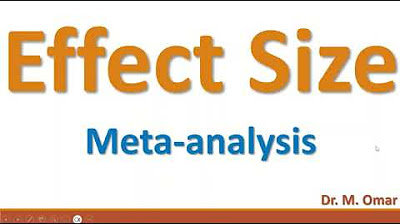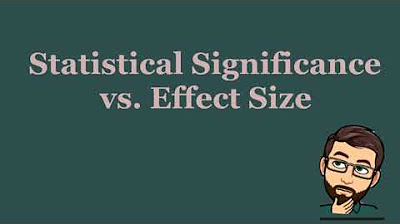Heterogeneity - Meta-Analysis Workshop Online Video Series Course
TLDRIn this educational module, Michael Borenstein discusses the critical yet often overlooked aspect of heterogeneity in meta-analysis. He emphasizes the importance of understanding the variability of treatment effects across different populations and studies, rather than just focusing on the mean effect size. Borenstein clarifies misconceptions about common heterogeneity statistics like Q value, I-squared, and Tau-squared, highlighting that they do not directly inform about effect size variation. Instead, he advocates for the use of prediction intervals to better comprehend and communicate the range of effects, which is crucial for making informed decisions in research and practice.
Takeaways
- 🧐 Heterogeneity is crucial in meta-analysis as it determines whether the impact of a treatment varies substantially across populations or remains consistent.
- 📉 The common focus on mean effect size in papers often overshadows the importance of heterogeneity, which can lead to misleading conclusions if not properly addressed.
- 📊 Statistics like Q value, I^2, and tau^2 are typically reported to quantify heterogeneity, but they do not effectively communicate the extent of effect size variation.
- 🔍 Understanding the dispersion of effect sizes is essential for a more accurate interpretation of meta-analysis results and for making informed decisions about treatment applications.
- 💡 The prediction interval is a key statistic that provides insight into how much the effect size varies across populations, offering a more meaningful measure of heterogeneity.
- 🚫 Misinterpreting heterogeneity metrics, such as mistaking I^2 values for direct measures of effect size variation, can lead to incorrect assumptions about treatment impacts.
- 📚 Michael Borenstein emphasizes the importance of moving beyond superficial reporting of heterogeneity statistics to a more nuanced understanding of effect size variation.
- 🔑 The role of heterogeneity in a meta-analysis is to inform about the range of effects and not just the average effect, which is critical for assessing treatment utility across different populations.
- 🤔 The presence of heterogeneity does not necessarily diminish the quality of a meta-analysis; instead, it can provide valuable information about the variability of treatment effects.
- 🛠️ Accurate estimation of heterogeneity often requires a larger number of studies, especially when the studies encompass diverse populations or treatment applications.
- ⚠️ The reliability of heterogeneity estimates can be limited with a small number of studies, highlighting the need for caution when interpreting results from such meta-analyses.
Q & A
What is the main focus of the video module presented by Michael Borenstein?
-The main focus of the video module is heterogeneity in meta-analysis, specifically discussing whether the impact of a treatment is consistent across populations or varies substantially.
What is the issue with the common approach to reporting heterogeneity in meta-analysis papers?
-The common approach to reporting heterogeneity in meta-analysis papers is superficial, often only reporting a Q value, I-squared, and Tau-squared without providing a clear understanding of how much the effect size varies across studies.
What does the video suggest should be the focus when the treatment has no impact in some populations but is exceptionally helpful in others?
-The video suggests that when the treatment has no impact in some populations but is exceptionally helpful in others, the focus should be on the range of effects rather than the mean effect size.
What is the purpose of the effect size index in the context of this video?
-The purpose of the effect size index in this context is to provide a standardized measure of the difference in means to assess the impact of a treatment, with different ranges indicating trivial, moderately useful, and exceptionally useful effects.
Why does the video argue that focusing solely on the mean effect size can be misleading?
-Focusing solely on the mean effect size can be misleading because it does not account for the variation in the effect size across different populations. It might suggest a treatment is effective when it is actually harmful or ineffective in some populations.
What is the role of heterogeneity in a meta-analysis according to the video?
-The role of heterogeneity in a meta-analysis is to understand how much the effect size varies across studies, which is crucial for interpreting the results and making informed decisions about the application of the treatment in different populations.
What is the difference between a prediction interval and a confidence interval as explained in the video?
-A prediction interval is an index of dispersion that tells us how widely the scores vary in the population, while a confidence interval is an index of precision that tells us how precisely we have estimated the mean, which is a property of the sample.
Why does the video emphasize the importance of understanding heterogeneity in meta-analysis?
-The video emphasizes the importance of understanding heterogeneity because it allows for a more accurate assessment of the effect size across different populations, which is essential for making informed decisions about treatment application and future research.
What is the meaning of I-squared in the context of heterogeneity?
-I-squared quantifies the percentage of the variance in observed effects that is due to true variance rather than sampling error. However, it does not provide information on the actual extent of the effect size variation.
How does the video suggest researchers should report heterogeneity in a meta-analysis?
-The video suggests that researchers should report the prediction interval to provide a clear and informative understanding of how much the effect size varies across populations.
Outlines
🔍 Introduction to Heterogeneity in Meta-Analysis
Michael Borenstein introduces the concept of heterogeneity in meta-analysis, emphasizing its importance in understanding the variability of treatment effects across different studies. He points out that while meta-analyses often focus on mean effect sizes, the dispersion of these effects is equally crucial. Borenstein criticizes the common practice of superficial reporting of heterogeneity through statistics like Q, I², and Tau², which do not adequately convey the extent of variation in effect sizes. He proposes a more nuanced approach to discussing heterogeneity and promises to provide a clear vocabulary for this purpose throughout the module.
📚 Common Mistakes in Heterogeneity Assessment
The segment discusses common misconceptions regarding heterogeneity in meta-analysis. It clarifies that statistics like I² do not measure the extent of variation in effect sizes, contrary to popular belief. The explanation includes an analogy comparing the misunderstanding of heterogeneity to misinterpreting the significance of a discount at a jewelry store. The paragraph emphasizes the need to look beyond mere statistical indicators and to understand the actual dispersion of effect sizes, which can be better achieved through the use of prediction intervals.
📉 Understanding Prediction Intervals and Heterogeneity
This part of the script explains the concept of prediction intervals in the context of meta-analysis and how they relate to heterogeneity. It distinguishes between the prediction interval and the confidence interval, highlighting that the former is a measure of dispersion in the population, while the latter indicates the precision of the mean estimate. The speaker illustrates how prediction intervals provide a range within which the effect size of a treatment is expected to fall in a significant proportion of comparable populations, offering a more practical measure of heterogeneity than other statistics.
📈 The Role of Heterogeneity in Meta-Analysis
The speaker refutes the misconception that heterogeneity is inherently negative in meta-analysis, arguing that it can provide valuable insights when appropriately assessed. He differentiates between meta-analyses with narrow and broad inclusion criteria, explaining that heterogeneity is more informative in the latter case. The segment emphasizes the importance of considering heterogeneity in conjunction with the mean effect size to understand the full spectrum of treatment effects across different populations.
🚫 Limitations of Heterogeneity Estimates
The script addresses the limitations of estimating heterogeneity, particularly in meta-analyses with a small number of studies. It compares the situation to estimating school math scores based on a sample of only five students, highlighting the unreliability of such estimates. The speaker suggests that when studies vary significantly, a greater number of studies is needed to reliably estimate heterogeneity, and when the number of studies is limited, researchers should acknowledge these limitations.
📝 Statistical Appendix on Heterogeneity
The final part of the script serves as a statistical appendix, providing a deeper understanding of the statistics related to heterogeneity. It explains the relationship between observed effects, true effects, and the variance due to sampling error. The speaker details how the Q statistic, I², and prediction intervals are derived from these values and the importance of choosing the appropriate statistic to answer specific questions about heterogeneity. The appendix aims to clarify misconceptions and provide a more accurate framework for interpreting heterogeneity in meta-analysis.
Mindmap
Keywords
💡Heterogeneity
💡Effect Size
💡Meta-Analysis
💡I-Squared (I²)
💡Q Value
💡Prediction Interval
💡Standard Deviation
💡Random Effects Model
💡Confidence Interval
💡Methylphenidate
Highlights
Heterogeneity in meta-analysis refers to the variation in treatment impact across different populations.
Common mistakes in meta-analysis often involve overlooking the importance of heterogeneity.
The mean effect size is frequently reported, but it doesn't account for variability across studies.
Heterogeneity statistics like Q, I^2, and Tau^2 are often misunderstood and don't directly convey the extent of effect size variation.
I^2 value, although used to quantify heterogeneity, does not actually indicate the range of effect sizes.
Understanding the dispersion of effect sizes is crucial for the proper interpretation of meta-analysis results.
The prediction interval is a key statistic that provides insight into the range of effect sizes across populations.
Primary studies and meta-analyses both require an understanding of heterogeneity, but the approach differs.
The standard deviation and prediction interval are more informative than the mean alone in both primary studies and meta-analyses.
Meta-analysis allows for the assessment of effect size variation, a strength over single studies.
Focusing solely on the mean effect size can be misleading if heterogeneity is ignored.
The process of understanding effect size variation is straightforward but often obscured by misleading statistics.
The role of heterogeneity in a meta-analysis is to inform the range of effects and guide future research directions.
Heterogeneity is not inherently negative; it can enhance the usefulness of a meta-analysis by revealing effect size variation.
The presence of heterogeneity necessitates a careful examination of the distribution of effects relative to the mean effect size.
The number of studies included in a meta-analysis can significantly impact the reliability of heterogeneity estimates.
Small sample sizes in individual studies can lead to inaccurate estimates of heterogeneity in a meta-analysis.
The prediction interval is a more practical and meaningful statistic for understanding and discussing heterogeneity.
Transcripts
5.0 / 5 (0 votes)
Thanks for rating:





